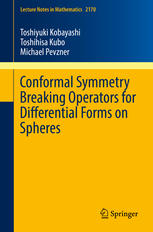

Most ebook files are in PDF format, so you can easily read them using various software such as Foxit Reader or directly on the Google Chrome browser.
Some ebook files are released by publishers in other formats such as .awz, .mobi, .epub, .fb2, etc. You may need to install specific software to read these formats on mobile/PC, such as Calibre.
Please read the tutorial at this link: https://ebookbell.com/faq
We offer FREE conversion to the popular formats you request; however, this may take some time. Therefore, right after payment, please email us, and we will try to provide the service as quickly as possible.
For some exceptional file formats or broken links (if any), please refrain from opening any disputes. Instead, email us first, and we will try to assist within a maximum of 6 hours.
EbookBell Team

4.0
96 reviewsThis work is the first systematic study of all possible conformally covariant differential operators transforming differential forms on a Riemannian manifold X into those on a submanifold Y with focus on the model space (X, Y) = (Sn, Sn-1).
The authors give a complete classification of all such conformally covariant differential operators, and find their explicit formulæ in the flat coordinates in terms of basic operators in differential geometry and classical hypergeometric polynomials. Resulting families of operators are natural generalizations of the Rankin–Cohen brackets for modular forms and Juhl's operators from conformal holography. The matrix-valued factorization identities among all possible combinations of conformally covariant differential operators are also established.
The main machinery of the proof relies on the "F-method" recently introduced and developed by the authors. It is a general method to construct intertwining operators between C∞-induced representations or to find singular vectors of Verma modules in the context of branching rules, as solutions to differential equations on the Fourier transform side. The book gives a new extension of the F-method to the matrix-valued case in the general setting, which could be applied to other problems as well.
This book offers a self-contained introduction to the analysis of symmetry breaking operators for infinite-dimensional representations of reductive Lie groups. This feature will be helpful for active scientists and accessible to graduate students and young researchers in differential geometry, representation theory, and theoretical physics.